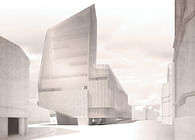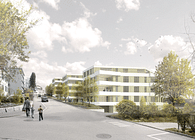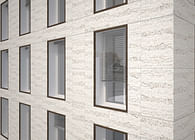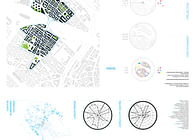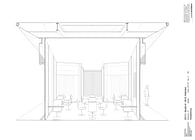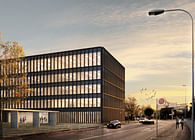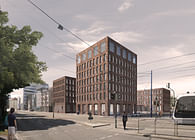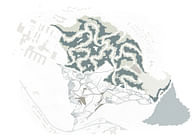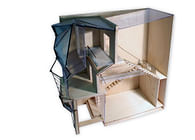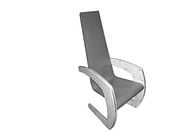
Nominated for RIBA President's Medals Student Awards
‘Side stepping the usual directions of contemporary architecture, this project is about architecture as a living and evolving entity. Architecture is often the manifestation of one mind and is notoriously time laden. It regularly finds itself out of sync with the very culture or circumstances it is developed for. However this confident and rational approach to urban development in Birmingham is approached as a natural state of growth rather than a preordained rigid proposal. It sees the architect as facilitator, simply providing a beginning rather than director.
The project seeks to address the assumptions on form generating processes in architecture; paralleling a wider scientific theory of order and progress in the natural world. The work happily lends insight from John Frazer’s work on Evolutionary Architecture and proposes nature as the generating force of architectural form. The strategy presented is clearly not about copying the organic, yet it carefully uses scientific and biological analogies to define a social polemic. The proposal feels aware of the writings of Rowe, Koetter, Gehl, and Lynch, yet it avoids a stereotypical response by simultaneously embracing Frazer’s ideas of replication and selection, challenging preconceived notions of space making.
The immediate urban field is disrupted by ‘cores’ or ‘seeds’ which themselves displace space within the public realm, creating a conscious dualism between figure and ground. Seeds are then organized according to the practical and pragmatic routes that connect to existing socio-physical nodes surrounding the site. All this allows for the future evolution of ‘cells’ or ‘units of habitation’ decided by the evolving needs of the occupants and wholly dependent on their social, economical and physical resources; all in an attempt to foster a communal sense of ownership in a severely
deprived inner-city area.
The presentation work and drawings demonstrates a rare graphical ability in collecting and presenting data, reinforcing the depth of thought and evident toil that lay behind this work. With regards to its overall ambition, with its carefully acknowledged utopian undertones - the work feels alive and evolutionary, with a potential only bounded by the limits of communities working together in unison toward a common goal.’
Kristian Alexander Hyde
2010
/ OVERVIEW
It is clear that the area is in need of urban regeneration; however a ‘total design’ approach or a Bilbao moment would result in an engineered society which is completely unsupportable in an area that changes as rapidly as this. The Council’s efforts have been directed at the City Centre; however the focus here is on the local environment. In order to accommodate this social change and cultural change, a mixed used urban regeneration scheme is in need. A large proportion of the scheme should support the fluctuation in inhabitants of the area, with focus on flexibility. However focus is needed to create opportunities to support the interests of the local community, which some have expressed as venues for entertainment such as music. This is very relevant to the culture of music of Birmingham and supports the need for reintroducing the industrial identity as the ‘environment was essential to creating this sound’ Economic stability in the area would also be beneficial as part of the regeneration scheme, which could include rentable shops, or small businesses that would support local produce. These elements however are still vulnerable in this relatively hostile environment, and will have little effect at preventing anti social behaviour. However, it should be considered that dedicated areas which are non-confrontational could help control this, such as dedicated graffiti walls treated as exhibitions, possibly with competitions. Regardless, a mixed used regeneration scheme should support private spaces as well as opportunities to improve social interaction through the diverse culture.
/ BRICOLAGE / BRICOLEUR
Inspired by the writings of Colin Rowe in Collage City, this explores the idea of an event governed by a collage of urban grain. As mentioned in the brief, the city should be able to grow and change through complex heterogeneous objects, supported by a nucleus or an event. It also refers to the sustainable concept of the ‘Bricoleur’; using the resources of the area to grow and develop.
/ GROWTH
Following on from the concept of Bricoleur, the concept of growth aims to respond very closely to the context of the site; not only physically but also socially, environmentally and economically. Dependant on the situation at the given time, the urban development should respond to this, and be flexible like the areas fluctuating nature.
/ REINTRODUCING INDUSTRY
A concept closely related to the Bricoleur, this is an attempt to recover what was abandoned and reintroduce an identity to the site. Although the city is keen to forget its industrial history, the industrial image has rooted itself deep in the culture of its people.
This evolutionary master planning model is a growing community dependant on economic, social and physical resources of its context. Inspired by John Fraser’s ‘Evolutionary Architecture’, growth is governed by the idea of seeds and cells, of which the former contain functions decided by its people, and the cells are housing modules that are borrowed and exchanged.
It has the capacity to accommodate from one to seven people in specific module configurations, and can reach a density of 3 in full growth. The aim is to support the fluctuating nature of today’s culture, be self sufficient and sustainable whilst establishing a sense of worth and pride.
Status: School Project
Location: Birmingham, GB
